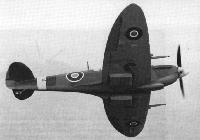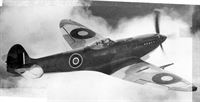Фотографии
-
Регистрационный номер: N3297 [2] The Spitfire III N3297 in its original form in March 1940 with blunt wing tips, forward-raked undercarriage legs, retractable tailwheel and enlarged oil cooler intake. Note the full wheel covers and experimental main radiator.
Самолёты на фотографии: Supermarine Spitfire - Великобритания - 1936
-
Регистрационный номер: N3297 [2] The Spitfire III N3297 in its original form in March 1940 with blunt wing tips, forward-raked undercarriage legs, retractable tailwheel and enlarged oil cooler intake.
Самолёты на фотографии: Supermarine Spitfire - Великобритания - 1936
-
Самолёты на фотографии: Supermarine Spitfire - Великобритания - 1936Supermarine Spitfire Mk.V - Великобритания - 1941
-
The reinforcement of Malta's defences in 1942 brought the first operational deployment of Spitfires outside of the UK. Shown here are tropicalised Spitfire VCs, with four-cannon armament, being loaded aboard the USS Wasp
Самолёты на фотографии: Supermarine Spitfire Mk.V - Великобритания - 1941
-
The reinforcement of Malta's defences in 1942 brought the first operational deployment of Spitfires outside of the UK. Shown here are tropicalised Spitfire VCs, with four-cannon armament, flying off the USS Wasp some 600-odd mis (about 1 000 km) from Malta.
Самолёты на фотографии: Supermarine Spitfire Mk.V - Великобритания - 1941
-
To allow the Spitfire VC to reach Malta from Gibraltar, a distance of 1,100 mis (1 770 km), the outsize 170-Imp gal (773-l) drop tank was developed; a larger oil tank had to befitted, deepening the nose cowling.
Самолёты на фотографии: Supermarine Spitfire Mk.V - Великобритания - 1941
-
Самолёты на фотографии: Supermarine Spitfire Mk.V - Великобритания - 1941
-
Регистрационный номер: X4922 Spitfire VA prototype (X4922) with the Vokes tropical filter and a wooden mock-up of the belly tank.
Самолёты на фотографии: Supermarine Spitfire Mk.V - Великобритания - 1941
-
A clipped-wing Spitfire VB with the Aboukir tropical filter.
Самолёты на фотографии: Supermarine Spitfire Mk.V - Великобритания - 1941
-
A clipped-wing Spitfire VB attached to the Air Fighting Development Unit, showing an unusual application of the unit’s code letters "AF".
Самолёты на фотографии: Supermarine Spitfire Mk.V - Великобритания - 1941
-
By 1942, the Spitfire VB was in large scale service with fighter squadrons in the UK. (Photo) A line-up of standard Mk VBs of No 131 Squadron, part of the Tangmere Wing, in June 1942 at Merston; note the old-style roundels on the aircraft nearest the camera.
Самолёты на фотографии: Supermarine Spitfire Mk.V - Великобритания - 1941
-
A pair of Spitfire IXs of No 32 Squadron operating over the beach-head south of Rome in 1944.
Самолёты на фотографии: Supermarine Spitfire Mk.IX / XVI - Великобритания - 1942
-
Регистрационный номер: MJ271 A standard production Spitfire IXC, showing the Aero-Vee filter that was fitted as standard, for temperate or tropical use.
Самолёты на фотографии: Supermarine Spitfire Mk.IX / XVI - Великобритания - 1942
-
Регистрационный номер: MJ238 In service with No 73 Squadron in Malta in 1945, this Spitfire IXC sports the squadron's pre-war fuselage insignia.
Самолёты на фотографии: Supermarine Spitfire Mk.IX / XVI - Великобритания - 1942
-
Регистрационный номер: AB197 Spitfire AB197 was one of the two definitive prototypes of the Mk IX, converted in the spring of 1942 by Rolls-Royce from a Spitfire VC. Photographed in May 1942, it still bears early-style roundels.
Самолёты на фотографии: Supermarine Spitfire Mk.IX / XVI - Великобритания - 1942
-
Supermarine Spitfire IX
Самолёты на фотографии: Supermarine Spitfire Mk.IX / XVI - Великобритания - 1942
-
Регистрационный номер: JF328 A pre-delivery shot of a Spitfire VIII in the early configuration, with extended wing tips and standard rudder. Note the retractable tailwheel and the Pokes Aero-Vee tropical filter.
Самолёты на фотографии: Supermarine Spitfire Mk.VI / VII / VIII - Великобритания - 1942
-
Регистрационный номер: X4942 [2] Ground view of the Spitfire VI trials aircraft X4942, showing the extended wing tips and the additional intake on the starboard front cowling for the cabin blower.
Самолёты на фотографии: Supermarine Spitfire Mk.VI / VII / VIII - Великобритания - 1942
-
Регистрационный номер: JF299 Mk VIII JF299 стал первым Spitfire с каплеобразным фонарем кабины. В таком виде самолет выполнил первый полет в середине 1943 года в Даксфорде. Изменения в конструкции не отразились на его летных данных, но существенно улучшили обзор из кабины и были внедрены на Mk VIII, Mk IX и Mk XVI послевоенной постройки, а также на оснащенных моторами Griffon самолетах Mk XIV.
A Spitfire VIII development airframe with the cut-down rear fuselage and rear-view canopy, later to be adopted on Mk IXs and Mk XVIs. Note the smaller "blister" ’fairings for the wing cannon, compared with those on the Mk VB and VC.Самолёты на фотографии: Supermarine Spitfire Mk.VI / VII / VIII - Великобритания - 1942
-
Spitfire VIII of the later production standard, with broad-chord rudder and standard wing tips.
Самолёты на фотографии: Supermarine Spitfire Mk.VI / VII / VIII - Великобритания - 1942
-
Регистрационный номер: X4942 [2] Air view of the Spitfire VI trials aircraft X4942, showing the extended wing tips.
Самолёты на фотографии: Supermarine Spitfire Mk.VI / VII / VIII - Великобритания - 1942
-
Регистрационный номер: AB450 The prototype Spitfire VII AB450, distinguished from the Mk VI most obviously by the retractable tailwheel and "C" wing armament.
Самолёты на фотографии: Supermarine Spitfire Mk.VI / VII / VIII - Великобритания - 1942
-
A production Mk VII, with the enlarged rudder, serving in the Orkneys in 1944.
Самолёты на фотографии: Supermarine Spitfire Mk.VI / VII / VIII - Великобритания - 1942
Статьи
- -
- Airdata File
- Fighter A to Z
- Model enthusiast
- ??? - British Aerospace 125. A European Bestseller
- ??? - Spitfire: Simply Superb /Warbirds/ (2)
- B.Johnston - Reno '84 in Retrospect
- M.Crean - The Boeing DH-4 Mail /Veteran & Vintage/
- M.Hirst - Civil Turbofan Engines (3)
- R.Braybrook - Does it gotta be teamwork?























